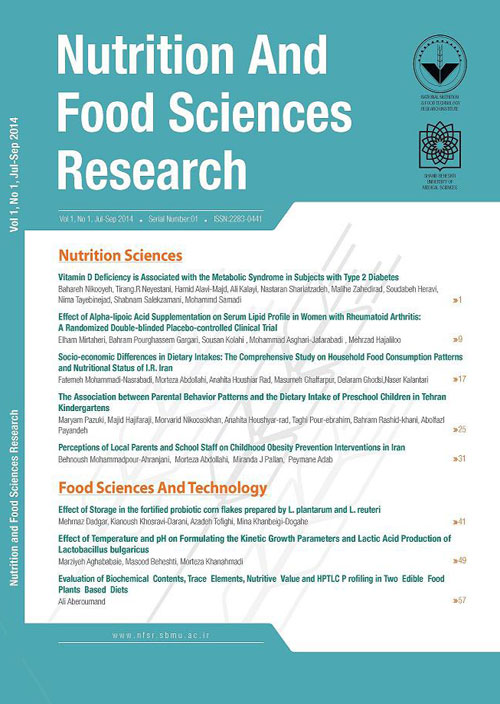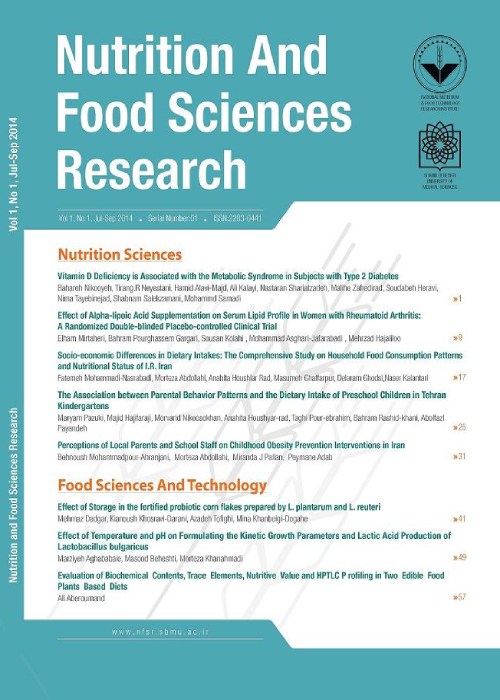فهرست مطالب

Nutrition & Food Technology Research
Volume:8 Issue: 3, Jul-Sep 2021
- تاریخ انتشار: 1400/04/20
- تعداد عناوین: 7
-
-
Pages 1-10
Hospitalization may affect patients’ nutritional status due to the altered food intake. In addition to their health consequences, plate food waste includes several economic and environmental costs for the governments and societies. Therefore, the aim of the present investigation is primarily to assess the nutritional status of the patients hospitalized in general wards and secondly to evaluate the quantity and financial burden of the patients’ food waste along with their possible nutritional outcomes. A mixed-method study is carried out in medical and surgical wards of general hospitals in Tehran with eligible adult inpatients. Anthropometric, demographic and dietary intake data are collected. Patients’ plate food waste in breakfast, lunch, and snacks within a day are weighed. The economic costs of food waste are calculated. Additionally, nutritional status is determined through 1) subjective assessment tools for malnutrition (MNA and SGA); 2) serum albumin, pre-albumin and total protein (protein status); 3) serum retinol and 25-hydroxycalciferol (micronutrient status); and 4) serum β-carotene, total antioxidant capacity, malondialdehyde and highly sensitive C-reactive protein (inflammatory status). Moreover, a qualitative study evaluates the possible reasons for wasting foods. This study provides appropriate data regarding the health and economic burden of food waste in the studied hospitals to healthcare authorities and policymakers for planning to decrease food waste and to improve patients’ nutritional status.
Keywords: Economic burden, Food waste, hospital, Malnutrition, Nutrition, Nutritional status, Qualitative study, Study protocol -
Pages 11-18Background and Objectives
Obesity is serious and most important underlying risk factor on incidence of non-communicable diseases (NCDs). In the last two decades, obesity has been on an increasing trend globally and across all age groups. Using dietary pattern analysis method could provide more information about nutritional etiology of chronic disease such as obesity. The aim of this study is to determine the association between major dietary patterns and general and central obesity among adults in Gonabad in 2019.
Materials and MethodsThis cross-sectional study included 250 individuals aged 18-70 years living in Gonabad, Iran. Participants were selected by a multi-stage sampling method. The dietary intake of participants during the past year was evaluated using the semi-quantitative Food Frequency Questionnaire (FFQ), which included 168 foods items. Factor analysis was used for identifying major dietary patterns. The relationship between major dietary patterns and general and abdominal obesity was assessed by chi-square test. All data were analyzed by SPSS 14 at significance level of P<0.05.
ResultsParticipants ages ranged between 18 and 70 years old, of whom 44.8% were male and 82.4% were married. Two healthy and unhealthy dietary patterns were identified. There was no significant relationship between unhealthy diet and height (p=0.82) and waist circumference (p=0.32) variables, but this dietary pattern was correlated with body weight (p=0.003), hip circumference (p< 0.001) and body mass index (p< 0.001). Also, there were significant relationship between healthy dietary pattern and height (p<0.001), weight (p<0.001), waist circumference (p<0.001), hip circumference (p<0.001) and body mass index (p=0.001).The unhealthy diet was significantly associated with general obesity (p <0.001) and abdominal obesity (p=0.01). Both general and abdominal obesity measures were significantly associated with Healthy dietary pattern (p = 0.003 and p <0.001 respectively).
ConclusionsMajor dietary patterns were significantly associated with general and abdominal obesity among adults in Gonabad. Further studies with future prospective studies, are required to confirm these findings.
Keywords: Dietary patterns, Obesity, Adults, Gonabad, Iran -
Pages 19-25Background and Objectives
Population growth and increased food requirements of humans have increased demands for agricultural foods. Indeed, food security is the foundation of a developed society and constitutes the major component of health, efficiency and learning. Based on the role of food security in human health and development, objective of the present study was to investigate statuses of food security in rural households of Iran and socioeconomic factors affecting these statutes.
Materials and MethodsFood security statuses of 19267 rural households were first assessed using income-expense questionnaires, 2018, and method of determining optimal food basket for the Iranian society based on the energy recommended by the Community Nutrition Department, Ministry of Health and Medical Education of Iran. Factors affecting food security were assessed using logit model.
ResultsResults of the food security index showed that rural households of Iran were generally at intermediate levels since the food security index values were higher than those of average in 53.12% of the rural households and lower than those of average in 46.88% of them. It was shown by the logit model that farm income, non-farm income, age, gender, educational level, employment status and house ownership status of household heads included significant positive effects on food security of the households. Moreover, family size and marital status of the household heads included negative effects on food security.
ConclusionsAlthough food security status of the Iranian rural families is relatively moderate, increasing nutritional knowledge and providing employment opportunities to increase incomes and purchase powers of optimal food baskets can be effective in improving food security.
Keywords: Food security, Logit model, Rural households, Socioeconomic factors, Iran -
Pages 27-36Background and Objectives
Food insecurity is recognized as a serious public health problem worldwide. Since household food security may affect health-related quality of life, the present study was carried out to assess associations of household food security with health-related quality of life in various districts of Tehran, Iran.
Materials and MethodsData of this cross-sectional study were collected from the Urban Health Equity Assessment and Response Tool (Urban HEART-2) Survey in Tehran Capital City, Iran, 2011, using multistage cluster random sampling method. From each household, one person was selected to participate. Data collection instruments included 6-item short-form to measure household food security status and SF-12V2 questionnaire to evaluate health-related quality of life. From 33252 people, 30521 people with ages of 18 years or greater were included in this study. Multiple linear regression model was used to assess independent effects of household food security on health-related quality of life.
ResultsAge range of the participants was 18–90 years with a mean age of 43.85 years ±16.2. Overall, 68.4% of the participants were female and 35.2% were male. Moreover, 62.2% of the participating households belonged to the food secure group. The mean score of the health-related quality of life was 60.5 ±19.4. The mean scores of health-related quality of life varied based on the household food security status in various districts of Tehran (p < 0.001). Multiple linear regression model showed significant relationships between health-related quality of life and household food security, adjusting age, gender, education, marital status, family size, body mass index and wealth and deprivation indices
(p < 0.001).ConclusionsResults showed associations of the household food security with health-related quality of life in various districts of Tehran. Policy makers are recommended to provide efficient interventions to promote quality of life of urban households based on the social determinants in each district.
Keywords: HRQOL, household food security, food insecurity, Urban HEART-2, Tehran -
Pages 37-47Background and Objectives
The objective of the current study was to investigate associations between food and nutrition literacy (FNLIT) and eating behaviors of elementary school children in Tehran, Iran.
Materials and MethodsIn this cross-sectional study, 803 students aged 10–12 years were participated from 44 primary schools in Tehran, Iran. A valid, reliable self-administered questionnaire was used to investigate participants’ food and nutrition literacy. A research-made questionnaire was used to assess eating behaviors of the students. Furthermore, the multinomial adjusted odds ratios of food and nutrition literacy for eating behaviors were analyzed.
ResultsFood and nutrition literacy cognitive domain included understanding food and nutrition information and nutritional health knowledge. Food and nutrition literacy skill domain included functional, interactive, critical food and nutrition literacy, food choice and food label literacy. High levels of food and nutrition literacy scores in the cognitive domain were negatively associated to irregular breakfast intakes compared to everyday eating breakfast (1–2 times a week, OR = 0.32, CI = 0.17–0.60), irregular lunch intakes compared to everyday eating lunch (never/1–2 times a week, OR = 0.40, CI = 0.17–0.93; 3–6 times a week, OR = 0.45, CI = 0.25–0.80) and irregular dinner intakes compared to everyday eating dinner (never/1–2 times a week, OR = 0.32, CI = 0.17–0.68). High food and nutrition literacy scores in the cognitive domain were attributed to never eating sausage/hamburger (OR = 2.20, CI = 1.01–4.83) and eating salty snacks 3–4 times a week (OR = 2.58, CI = 1.09–6.13). The FNLIT scores in the skill domain were negatively associated to irregular breakfast intakes compared to everyday eating breakfast (3-6 times a week, OR = 0.33, CI = 0.13–0.78). Food and nutrition literacy scores in the skill domain were positively associated to never eating sweet snacks (OR = 4.19,
CI = 1.39–12.62).ConclusionsThe current manuscript highlights the necessity of continuous improvements in health education curriculum of schools in Iran, particularly highlighting the importance of greater attention needs to practical and skill-based lessons rather than theoretical lessens. Further studies with long-term follow-up plans are needed to understand associations between food and nutrition literacy and eating behaviors more comprehensively.
Keywords: Food, Nutrition literacy, Eating behaviors, School-age children, Iran -
Pages 49-58Background and Objectives
In this study, antibacterial effects of whey protein coating with Mentha aquatica L. essential oil on Escherichia coli, Enterobacter and Klebsiella pneumoniae in Iranian white cheese were investigated.
Materials and MethodsMentha aquatica L. essential oil was extracted using Clevenger apparatus. Mentha aquatica L. essential oil was added to each whey protein coating solution at 0.5, 1 and 1.5% concentrations. Whey protein treatment included cheese, bacteria and whey protein with no Mentha aquatica L. essential oil. Control treatment only included cheese and bacteria with no Mentha aquatica L. essential oil and whey protein. Minimal inhibitory concentration and minimal bactericidal concentration were assessed for the bacterial species. Antibacterial properties of the designed active coating system against Escherichia coli, Enterobacter and Klebsiella pneumoniae were assessed using direct cell counting and disk diffusion methods.
ResultsMentha aquatica L. essential oil at 1.5% concentration at the end of Day 15 of storage at 4 °C inhibited growth of Escherichia coli, Enterobacter and Klebsiella pneumoniae up to 100, 64 and 18%, respectively. To achieve the highest growth inhibition of Escherichia coli, Enterobacter and Klebsiella pneumoniae, 1.5, 1 and 1% of the essential oil were used to preserve organoleptic properties of the cheese.
ConclusionsUse of whey protein coating with 1.5% essential oil included no adverse effects on organoleptic, sensory and appearance characteristics of the cheese. Whey protein coating with Mentha aquatica L. essential oil inhibited growths of Escherichia coli completely and Enterobacter partially in Iranian white cheese.
Keywords: Biopolymer coating, Enterobacter, Escherichia coli, Essential oils, Food protection, Dairy products, Klebsiella pneumonia -
Pages 59-65
Herbs are natural products and herbal medicine has become a popular form of healthcare. Herbal-derived remedies may increase pharmacological qualities and improve prevention and treatment of several diseases. In this study, all relevant articles in English language were collected. Keywords of milk thistle, myrrh, mint and natural products were searched in Google Scholar, Scopus, Research Gate and PubMed databases. Milk thistile is a valuable widely-consumed botanical used for its various health benefits. The plant is an annual herb, belonging to Asteraceae family, which ripe seeds contain flavonoid substances. Myrrh is a sap-like substance, which is released from cuts in the barks of trees. The plant is a member of Commiphora genus. Mentha spicata is a species of mint native to Europe and South-East Asia. Mint is a creeping rhizomatous and perennial herb. In this mini-review, key roles and pharmaceutical benefits of milk thistle, myrrh and mint are described.
Keywords: Milk thistle, Myrrh, Mint, Health benefits, Natural medicine


